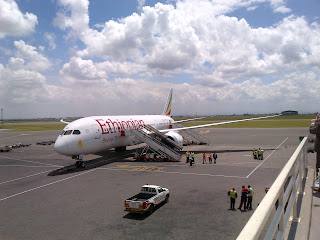If I had to guess, I'd say that the cause of the fire on an Ethiopian Airlines Boeing 787 Dreamliner is not going to be keeping air safety investigators awake nights for long but something else might. The origination of the blaze may already be known by the Air Accidents Investigation Bureau and that is one giant step towards finding how why it started.
I am not buying the fire-in-the-battery of the emergency beacon or for that matter the cigarette-in-the-trash-can scenario. Nor am I inclined to write this one off as just another shake out issue on the world's newest airplane. My suspicions are fueled by a few people I know who have intimate knowledge of the Dreamliner, its innards and the carbon fiber material out of which it is constructed.
"If it is hot enough to melt composites, that was not a cigarette, it had some energy behind it," someone familar with the Dreamliner's design told me, after having seen the photo of a charred eight foot section of the plane's roof. "Looking at that fire, at the heat damage, there was electrical power behind that."
According to this contact, who works in the industry and prefers not to be identified, there is only one electrical source in the area below the fire damage, the power electronics cooling system, a aviation-grade radiator that pumps cool Prestone-like fluid past hot equipment to lower the temperature and prevent equipment overheating.
As a reminder, since before the very first Dreamliner flight, we have heard about how this plane is a whole other level of revolutionary; with a fuselage of new-fangled composites and digitized to the point where how, when and even whether the toilet flushes is determined by a circuit board outside the loo.
There's something else about the Dreamliner that's become obvious, this is an airplane that requires a lot of hand-holding.
 You don't want me to write another word about those confounded lithium ion batteries and I'm not gonna. One thing that's changed since the 787 returned to the skies after its four months of not flying is that some airlines want to keep the airplane plugged in while on the ground in order to keep those persnickety devils fully charged. Or as one Dreamliner technican explained to me, "You can only lose two volts before you have to take them off the airplane and send them back to the manufacturer and have them charged again." At $40,000 a pop, some coddling of the batteries is in order.
You don't want me to write another word about those confounded lithium ion batteries and I'm not gonna. One thing that's changed since the 787 returned to the skies after its four months of not flying is that some airlines want to keep the airplane plugged in while on the ground in order to keep those persnickety devils fully charged. Or as one Dreamliner technican explained to me, "You can only lose two volts before you have to take them off the airplane and send them back to the manufacturer and have them charged again." At $40,000 a pop, some coddling of the batteries is in order.This may be why Ethiopian was treating its Queen of Sheba ET-AOP like a Queen, plugged into the ground power supply while waiting for the daily 9:00pm flight from London to Addis Ababa. Investigators have said no power was being supplied to the plane, though it was connected to an electrical source.
Clarification of this point is very important. Unlike aluminum airplanes which radiate heat, the Dreamliner's composite fuselage hangs on to it. An aeronautical engineer described the airplane as being like a Thermos bottle. If no power was being supplied, the airplane baked in the summer sun for eight hours elevating the interior temperature to, well, who knows?
If the power was on and all those nifty electronic gizmos were whirring away, then the power electronics cooling system should have been running too, pumping hot air out and cool air over the assortment of heat-generating equipment.
So from this second scenario, one armchair theory is that the power electronics cooling system may have had a role in the fire, either triggering it through a short circuit, or feeding a blaze started elsewhere.
 |
| NTSB's Bob Swaim examines wiring from TWA 800 |
 |
| Installing airplane wiring photo courtesy Labinal |
"Somebody made the decision to use it," I was told of Boeing and the French company Labinal that specializes in electrical wiring that Boeing hired for the Dreamliner project. "It will come and bite Boeing on the ass," this person added. "We have a lot of problems with this airplane because of the wiring."
Much of the reporting of the Ethiopian Dreamliner fire of last Friday suggests Boeing has dodged a bullet since the blaze seems unrelated to its previous battery problems. But if the folks talking to me about overheating equipment, delicate wiring and airplanes that need their hands held are even in the vicinity of correct, there's more to worry about on the world's most modern airplane. Time for the hand-wringing to begin.
AAIB issued an update today at 11:00 EST. Read it here.



1 comment:
Your wiring theroy needs some more research.
Teflon wiring was banned by major manufacturers in 1983. Kapton in 1992. All Boeings and Airbuses use substantially the same wire TKT, in their aircraft.
"Arc-track resistant, Abrasion resistant, Superb insulation protection, High heat tolerance,Resists smoking when burning (less than 2% density), Displays all the positive aspects of Kapton (i.e. ightweight, resistance to burning, no fumes when burning etc) without any of Kapton's negatives."
Post a Comment